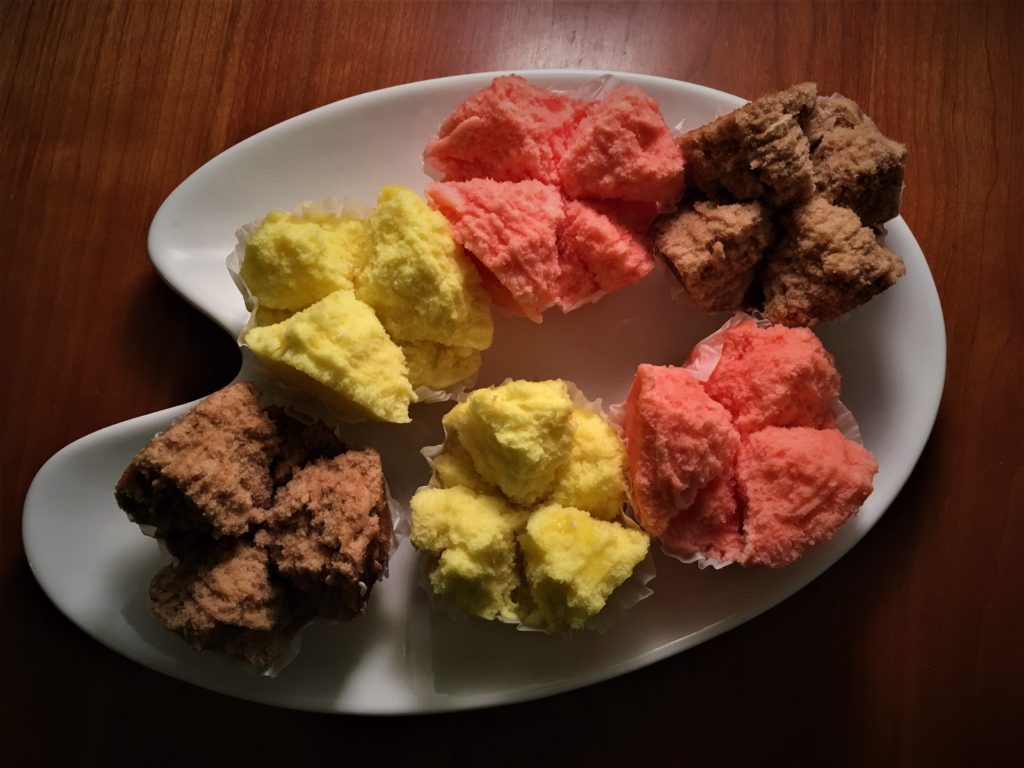It is the eve of Lunar New Year. People travel long distance by car, by train or by planes to return to their hometowns. For some families, it means to have several generations all gather under one roof—once in a year. Every family has its favorite dishes for New Year’s Eve reunion dinner 團圓飯. There are also regional specialties. However, based on traditions, a few items are must-haves on every table: chicken, fish, oranges and rice cakes.
In Mandarin Chinese, chicken 雞 is pronounced “jī” while the character for luck or auspicious 吉 is pronounced “jí.” Other than the tonal differences, they sound very similar. For New Year celebration, chicken is often paired with chestnuts 栗, which sound the same as “advantageous” 利 — “lì.” 吉利 is good fortune. Fish 魚 and overabundance 餘 are homophonous— “yú.” “Having fish” 有魚/有餘 is a reassurance of plenitudes in the coming years.
The character for citrus is “桔”: One side means “wood or plant;” the other side, “luck.” With their golden color, oranges are symbols of prosperity. The name “kumquat” derives from the Cantonese pronunciation for 金橘 “golden orange.” Candied kumquats are popular treats during this time of the year. Small kumquat plants are common celebratory decorations.
There are many varieties of rice cakes, from plain to sweet, from sticky to leavened. Regardless of the differences, they all signify “promotion and prosperity” in the new year, since cake糕 shares the pronunciation with 高 “high”— “gao.” Flour of glutinous rice is the main ingredient for these cakes. Sticky 黏 and year 年 is another set of homonyms— “nian.” White sticky rice cakes, shaped in strips and flavorless, are usually sliced crosswise into small piece and used in savory dishes. Sweet sticky rice cakes are larger in size, often in the color of brown sugar, sometimes flavored with Osmanthus or orange peels. They can be sliced and eaten cold or heated. Battered and deep-fried sweet rice cake was my favorite winter snack. The ones with orange peels were the best.

發糕 (fa gao) is a type of leavened rice cake, popular in southern China and Southeastern Asia.[1] Although they have the appearance of cupcakes, they are steamed and not baked. One of the most popular New Year’s greetings is 恭喜發財 (“gon-xi-fa-cia”—wishing you prosperity, making lots of money). As a wish for progress and fortune in the new year, mom would buy 發糕 every year. Their rough texture and plain flavor never interested me as a child. But, after I left home, they were the one thing that I really missed.
Every year before we sat down for the feast, we would worship our ancestors. My parents were not religious. But we all took the ceremony seriously. We raised incense sticks and bowed three times. I always took it as a way to give thanks. Dad insisted that there must be nine dishes on the table. (He wasn’t very good at explaining the reason.) I remembered that, in some years, when mom came up short of nine dishes, she would divide some dishes into smaller portions—just to follow the ritualistic rules.
On any other days of the year, mom would ask us to finish everything in our bowl. On New Year’s Eve, mom would say to leave a bite, for good luck—有餘. With so much food on the table, by the time I tried a bite of everything, I would be full already. Before the table was cleared, Little Cop would already be out with his friends trying out their firecrackers. Every year, I tried to stay up till midnight, wanting to hear the huge strings of firecrackers chasing away the 年 monster. Every year, I fell asleep with my tummy full and my heart content, knowing that there would be a red envelope under my pillow in the morning. In my sweet dreams, I seemed to have heard the exciting sounds of firecrackers.



